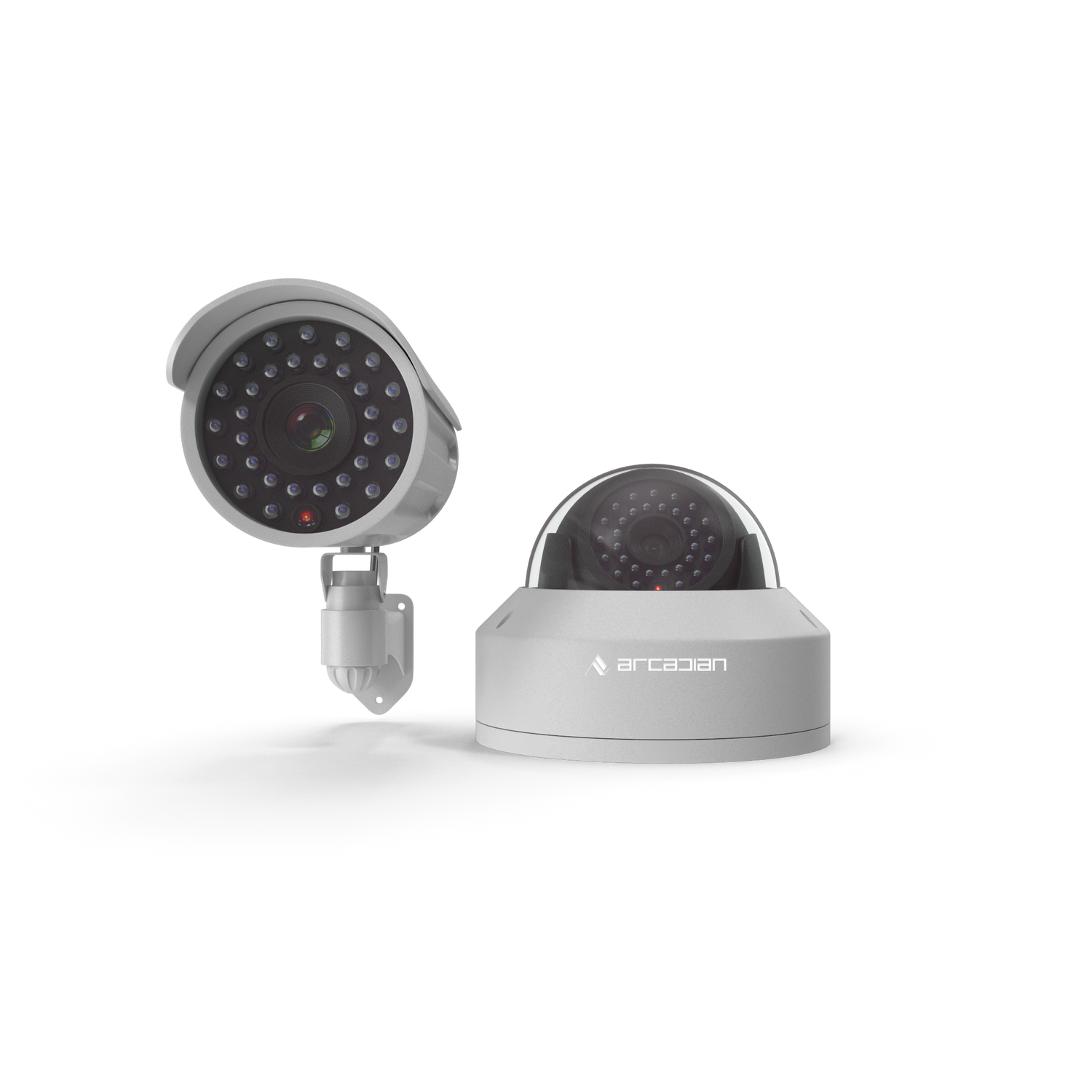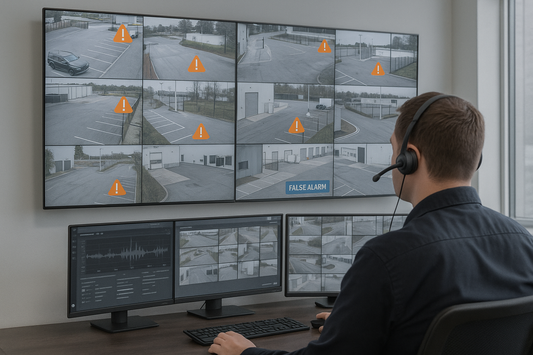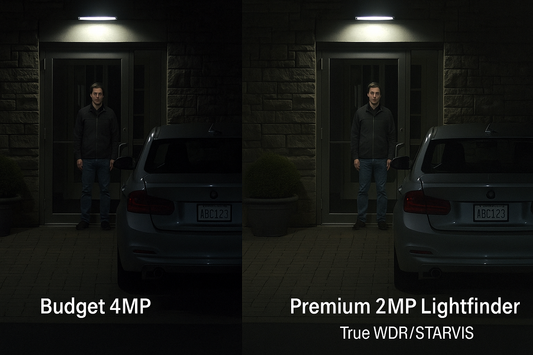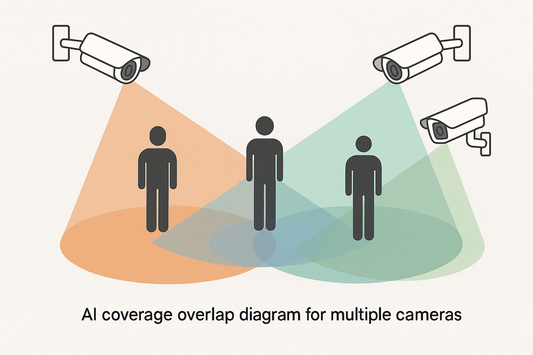How to Choose the Right Security Camera (And Why Two “Identical” Specs Can Cost Very Different)
Most cameras look the same on paper. They aren’t. This deep, brand- and model-based guide shows how sensor families, optics, build, firmware, warranties, compliance, and vendor lock-in affect both price and performance—so you can buy like a pro.
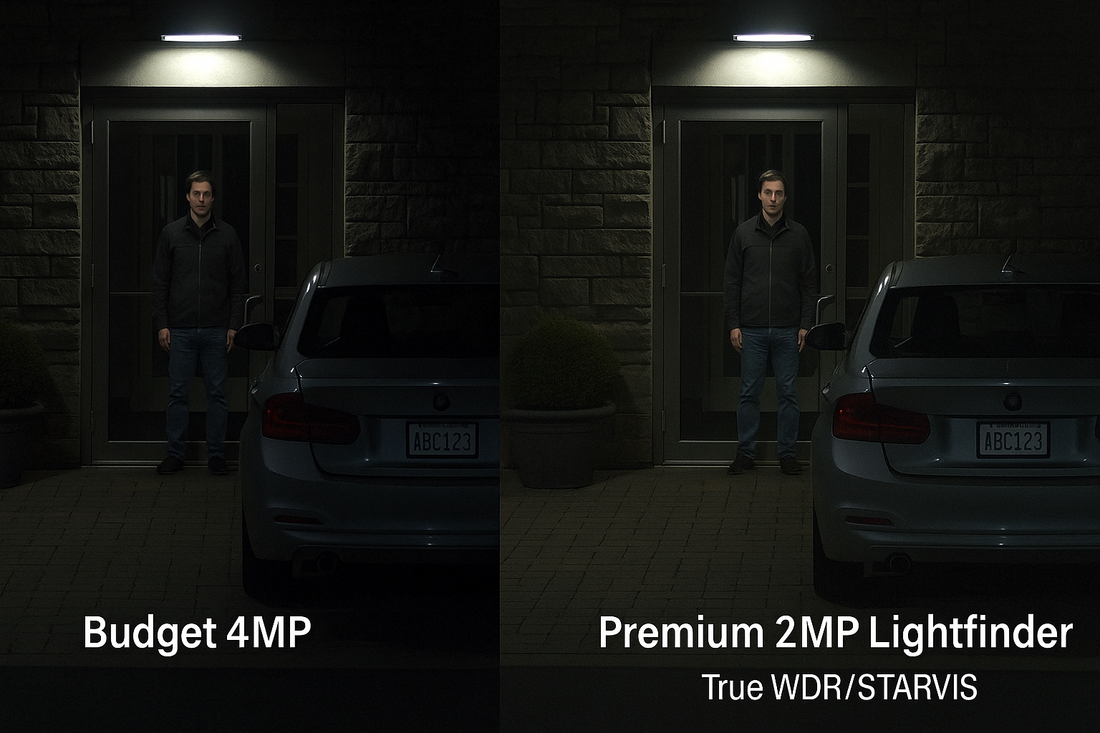
Introduction
ArcadianAI is camera-agnostic: Ranger works with leading brands and open standards, so we see—in real deployments—why one “4MP dome with IR + WDR” costs $130 while another is $800+. The spec sheets look similar, but sensor generation, real WDR method, lens quality, SoC, firmware, IK/IP durability, support, warranty, and compliance (e.g., NDAA) drive massive differences in outcomes and total cost of ownership. We’ll decode these factors with concrete models from Axis, Hanwha Vision, Hikvision, Dahua, Uniview, Bosch, Ubiquiti, Avigilon, Verkada, Lorex/Swann/LTS (OEM lines), and more—then show how an open, camera-agnostic platform avoids hardware lock-in versus proprietary VSaaS (e.g., Verkada). Axis and Hanwha both offer 5-year warranties; that alone changes TCO and price logic.
Quick Summary / Key Takeaways
-
Specs lie; sensor generation and WDR type matter.
-
Price tracks build (IK/IP), optics, SoC, firmware, and warranty.
-
OEM/ODM rebrands exist; compliance and updates vary widely.
-
Open standards (ONVIF) preserve flexibility; lock-in adds TCO.
-
Match camera to scene (light, distance, motion) before “megapixels.”
Background & Relevance — Why Camera Choice Is Hard Now
Vendors compress nuanced engineering into a few buzzwords. “WDR” might be true multi-exposure (far better) or simple digital gain; “4MP” night video may still smear without the right sensor/HDR. Meanwhile, buyers must navigate NDAA rules (e.g., Section 889 bans for certain brands/components) and FCC restrictions, which also influence price and availability in North America.
Core Topic Exploration
1) Why do two cameras with “the same specs” have different prices?
Because the underlying parts and engineering differ:
-
Sensor family & generation: Sony STARVIS/STARVIS 2 sensors deliver higher low-light sensitivity and HDR; older/cheaper sensors struggle at night.
-
WDR method: “True WDR” fuses multiple exposures per frame; “digital WDR” is software tone-mapping with inferior results in backlight.
-
Optics: Real P-Iris, low-distortion lenses, accurate IR cut filters, and well-matched IR arrays add cost—and clarity. (See Hanwha PNV-A9081R’s P-Iris + 120 dB WDR.)
-
SoC & analytics: DL-capable chipsets (edge AI, better noise reduction/HDR pipelines) cost more (Axis P3265-LVE uses DLPU; analytics quality differs).
-
Build & durability: Impact (IK) and ingress (IP) ratings reflect materials, gasketing, and vibration resistance; IK10/IP66–68 housings cost more to manufacture.
-
Firmware & updates: Long-term security updates, hardening, and SDKs cost vendors money; enterprise brands recoup via price.
-
Warranty & support: Axis and Hanwha standardize 5-year warranties—valuable for TCO; budget gear is often 1–3 years.
-
Compliance & supply chain: NDAA compliance excludes restricted components/brands—affecting BOM and price.
2) What’s the practical difference you’ll see in footage?
-
Night scenes: STARVIS/STARVIS 2 sensors + true WDR preserve faces/plates where cheaper sensors blur or blow highlights.
-
Backlit doors/drive-aisles: True WDR (>120 dB) + good optics hold detail in sky and shaded faces simultaneously; digital WDR often leaves one clipped.
-
Harsh sites (industrial, coastal, bridges): Rugged PTZs (e.g., Bosch MIC) bring IP66/68 & IK10, heaters, and anti-vibration—costly but mission-critical.
3) Which specs are “must check” beyond resolution?
-
Sensor family & pixel size (e.g., STARVIS/STARVIS 2 lineage).
-
WDR type & rating (look for “true WDR, 120 dB+”).
-
Lens & aperture (F-number, P-Iris, low distortion).
-
IR design (range, spread, ghosting control).
-
IK/IP (IK08–10, IP66–68) for vandal/outdoor duty.
-
ONVIF profile(s) (T for video streaming; G for recording/control; M for metadata/analytics) to avoid lock-in.
-
Warranty & long-term firmware policy (ideally 5 years).
-
Compliance (NDAA/FCC import status if you operate in the U.S.).
4) OEMs: Why do many brands look (and price) similar?
OEM/ODM explains it. An ODM designs and builds a camera that multiple brands private-label; an OEM builds to a brand’s own design/IP. ODM/shared designs can create look-alike models across different labels (e.g., Dahua-derived or Hikvision-derived lines sold under other names), but firmware, QA, and support programs still vary—affecting security updates, integration, and warranty.
Examples relevant to North America
• Lorex: formerly owned by Dahua; later sold to Taiwanese firm Skywatch.
• LTS/Amcrest/others: often cited as selling Dahua/Hikvision-derived models in various periods (always verify current lineage and compliance).
5) Open vs. Proprietary Platforms: Will your camera “work anywhere”?
-
Open (ONVIF-friendly): Lets you change VMS/VSaaS later. ArcadianAI’s Ranger is camera-agnostic and plays well with open standards.
-
Proprietary VSaaS (e.g., Verkada): Hardware + mandatory per-camera cloud licenses; convenient but creates long-term TCO and switching-cost commitments.
-
Hybrid cases (Ubiquiti Protect): Increasing ONVIF ingest, but feature limits vs. first-party cameras (e.g., motion/AI).
6) Concrete model contrast: why prices diverge
-
Budget 4MP vandal dome (Hikvision DS-2CD2143G2-I) — 4MP, 120 dB WDR, IK10/IP67; widely available around the low $$$ tier. Good value, basic analytics.
-
Upper-mid 2MP deep-learning dome (Axis P3265-LVE) — 2MP but Lightfinder 2.0, Forensic WDR, DLPU analytics, rich cybersecurity stack, and 5-year warranty.
-
Premium 4K AI dome (Hanwha PNV-A9081R) — 4K, 120 dB WDR, P-Iris, gyro DIS, strong on-edge AI, and 5-year warranty standard.
-
Extreme-duty PTZ (Bosch MIC 7000/7100/7600 series) — IP66/68, IK10, heaters, shock/vibration resistance; built for bridges, ports, and heavy industry.
7) Lens & FOV: Why lenses and mounting change everything
-
Fixed 2.8 mm is cheap/wide but distorts and loses detail at distance.
-
Motorized varifocal (e.g., 3–10 mm) lets you “zoom to purpose” and maintain pixels-on-target.
-
P-Iris stabilizes depth of field in daylight; fast apertures help nights. (See PNV-A9081R P-Iris.)
8) Durability: Which ratings actually matter?
-
IK rating: measures impact resistance; IK10 is the typical “vandal dome” level.
-
IP rating: measures dust/water ingress (IP66/67/68 are outdoor-ready tiers).
9) Compliance 101 (US buyers): NDAA/FCC in plain English
Section 889 of the U.S. NDAA restricts certain manufacturers/components from federal use and federally funded projects. The FCC has also limited new equipment authorizations for some brands. This affects what integrators will sell/support—and influences price and availability. Always verify current NDAA alignment in bids.
Comparisons & Use Cases
Table: “Same-Spec” Isn’t Same Outcome
| Use case | Budget pick | Premium pick | What changes in practice |
|---|---|---|---|
| Backlit entry (faces) | 4MP dome w/ “WDR” | Axis P3265-LVE | True multi-exposure HDR + Lightfinder keeps facial detail vs. blown highlights. |
| Wide retail aisle | 4MP fixed 2.8 mm | Hanwha PNV-A9081R 4K | 4K + P-Iris + AI best-shot reduces blur and improves analytics accuracy. |
| Port/bridge PTZ | Generic outdoor PTZ | Bosch MIC 7xxx/7600 | Survives salt, vibration; IP66/68, IK10, heaters—fewer truck rolls. |
| Budget parking lot | Value 4MP turret | Value + better lens | Spend on varifocal optics first; pixels-on-target > raw megapixels. |
| Multi-site cloud | Proprietary VSaaS cam | ONVIF + open VMS/VSaaS | Avoid per-cam lock-in; preserve choice and lower lifetime TCO. |
How ArcadianAI (Ranger) Fits
Because Ranger is camera-agnostic and ONVIF-friendly, you can mix Axis/Hanwha “anchor” cameras in critical scenes with value gear elsewhere—and still get consistent AI events, multi-camera correlation, and lower false alarms. Open means you can upgrade problem scenes later without ripping out your whole stack. (We routinely ingest Profile T/G/M devices and unify alerts.)
Buying Checklist (Copy/Paste)
-
Scene first: light (day/night/backlight), distance, angle, motion.
-
Sensor/WDR: STARVIS/STARVIS 2 or equivalent + true WDR (≥120 dB).
-
Lens: choose focal length for pixels-on-target; prefer varifocal/P-Iris in variable light.
-
Durability: IK / IP ratings matched to risk (IK10, IP66/67/68).
-
Platform: ONVIF profiles for future flexibility (T/G/M).
-
Warranty/Support: aim for 5 years where possible.
-
Compliance: verify NDAA/FCC status for your vertical.
Common Questions (FAQ)
Is 4K always better than 2MP?
Not at night or in tough HDR; a 2MP with better sensor/WDR can beat a cheap 4K.
Do I need IK10?
If the camera is within reach or in rough environments, yes; otherwise, IK08 may suffice.
Will Ubiquiti Protect work with my existing ONVIF cameras?
Often, but some advanced features (motion/AI) are limited for third-party devices.
What’s the catch with proprietary VSaaS?
Per-camera licenses and hardware lock-in increase lifetime TCO; weigh convenience vs. flexibility.
Are OEM brands “bad”?
Not necessarily. Judge by firmware quality, security updates, warranty, and compliance—not the badge alone.
Conclusion & CTA
Great camera buying is scene-driven, not spec-driven. Price differences come from real hardware, firmware, durability, and support deltas that your ROI will feel—especially at night and in harsh light. Pick the right optics/sensor/WDR for each scene, keep your platform open with ONVIF, and use a camera-agnostic AI layer to standardize alerts and outcomes.
See ArcadianAI in Action → (Ranger on your existing cameras)
Security Glossary (2025 Edition)
AI on the Edge — Analytics running in-camera on a DL-capable SoC.
Forensic WDR — Multi-exposure HDR tuned for detail retention (Axis term).
IK Rating — Mechanical impact resistance of enclosures (IK00–IK10).
IP Rating — Dust/water ingress rating (e.g., IP66/67/68).
Lightfinder 2.0 — Axis low-light tech for color/clarity in dark scenes.
NDAA Section 889 — U.S. restriction on certain manufacturers/components.
ONVIF Profiles — Interop specs; T (streaming), G (recording), M (metadata).
P-Iris — Motorized iris maintaining optimal aperture for DOF and sharpness.
STARVIS/STARVIS 2 — Sony back-illuminated sensors with high low-light/HDR.
True WDR (Multi-Exposure) — Captures multiple exposures per frame; better than “digital WDR.”
Pro Tip: Start with a scene matrix. For each camera: distance to subject, lighting extremes, elevation/angle, vandal risk, weather, and analytics goal. Then pick sensor + lens + WDR + rating for that row. Price is a by-product of fit. Not the other way around.

Security is like insurance—until you need it, you don’t think about it.
But when something goes wrong? Break-ins, theft, liability claims—suddenly, it’s all you think about.
ArcadianAI upgrades your security to the AI era—no new hardware, no sky-high costs, just smart protection that works.
→ Stop security incidents before they happen
→ Cut security costs without cutting corners
→ Run your business without the worry
Because the best security isn’t reactive—it’s proactive.
